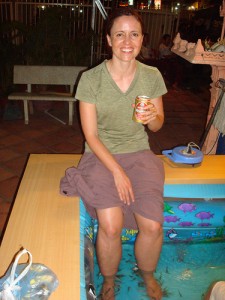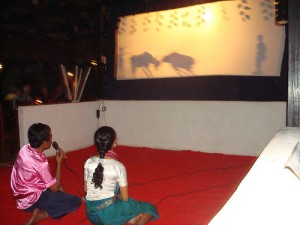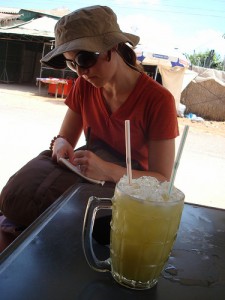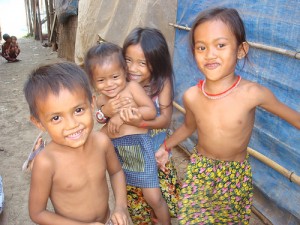We are in Hanoi, after spending a couple nights in Sapa. We are missing the heat of Cambodia, as Vietnam has us breaking out our fleeces, long pants and sneakers.
We shared one day of our trip to Cambodia, and we wanted to share a few of our other memorable Cambodian experiences while they are fresh in our memories. Some good, some not – but memorable nonetheless.
1. Sex tourists in Phnom Penh
We saw a lot of literature in both Thai and Cambodian bookshops about sex tourism and child/adult sex slavery. Though we had seen the books, we hadn’t seen anything blatant until Phnom Penh. Our first night there we stayed on the riverfront, in a guesthouse by a lot of bars and restaurants. Walking around at night, we saw a few dolled up Cambodian women in the bars, and one obviously propositioning a European tourist. Later that night, Mark was online in the lobby and saw three different Caucasian men take pros up to their rooms. At breakfast the next morning, we sat next to an Aussie guy and his “date” from the night before, and he paid her off. Once we keyed into the typical profile of the john, we saw them everywhere: white, mid-40’s to early 60’s, slightly to very unattractive…and there were lots of them. The women looked like they were in their early-mid 20’s. We didn’t see any blatantly underage girls out, but assume it happens but with more discretion.
2. Dr. Fish Massage
A fad in Siem Reap, dozens of enterprising shopkeepers have set up “Dr. Fish Massage” pools. These pools are filled with about six inches of water a few hundred tiny fish. Three dollars buys you 20 minutes of time with your feet in the pool AND a cold beer. The fish nibble on your dead skin, and at first it feels kind of electrifying, and then mildly ticklish. My feet felt refreshed afterward, but contrary to the promotional signage I didn’t notice any long-lasting effects!
3. Shadow Puppet Theater
Much of traditional Khmer arts and culture was lost under the Khmer Rouge, when most of the educated population was killed or fled the country. Khrousar Thmey, the organization that ran our guesthouse in Siem Reap, is working to help young Cambodians learn their native traditions. One almost-lost Cambodian art is shadow puppet theater.
The children make intricate puppets out of cattle hide, and use them to tell stories from behind a white sheet that is illuminated to create shadows. The theater troupe was made up of youths in their early teens, and it was fun to watch the narrators act out the different voices while the puppeteers synchronized the puppets’ movements. They troupe seemed to be having a lot of fun – I peeked behind the stage and saw giggly teens manipulating their puppets while joking around. It was nice to see happy, laughing kids.
4. Sugarcane Juice
Walking down a red dirt road in Siem Reap, we came across a small “food court”: a handful of vendors and their food stalls gathered under an open air shack with a corrugated roof. One of the women was selling sugarcane juice. It was hot and we were thirsty, so we stopped. She offered us a glass – a real glass beer mug – and we sat down at the plastic table on tiny little plastic stools. The juicer was powered by a gas generator, and she fired it up and fed in a few canes. The green juice was sweet. We relaxed for a few minutes and watched the local action: another vendor chasing flies away from her dried fish with a homemade fly distractor – a stick with a plastic bag tied to it. A young local placed a to-go order from the sugarcane lady, and she juiced a couple servings. The to-go containers were small plastic bags filled with juice, ice and a straw.
5. A Visit to the Great Lake Tonle Sap (by Mark)
After exploring the stunning achievements of the Khmers of the 9-13th centuries, we decided to take a day trip to a floating village on the great lake Tonle Sap to understand how many Cambodians live today. Tonle Sap is the largest freshwater body of water in SE Asia, and more than half of Cambodians’ protein intake comes from its fish. The lake is extraordinary in that during the dry season, water flows south from the mountains toward the Gulf of Thailand. However, in monsoon season, the flow actually reverses, and serves as a great reservoir for the torrents of water coming down the Mekong River. At this time, the lake grows to cover nearly six times as much land.
Our experience in Siem Reap and around the temples led me to believe that to Cambodians, tourists are primarily giant dollar signs. We also saw a depth of need in the Cambodian cities unlike any we have encountered before. Heading to the lake and surrounding towns, we witnessed a change as great as that of the Tonle Sap itself. Here were a people no less materially impoverished, but with a joy for life and for each other. We were regarded not primarily as a source of income, but rather as perhaps somewhat curious individuals with a funny language and way of dress and transport. Here, Cambodians make their living drying fish in the sun, making sugar and wine from palm sap, farming fish in the rivers, cultivating rice, and teaching skills to the next generation of Cambodians. I trust that these joys must too exist for many Cambodians living in the cities, but perhaps behind the closed doors of the city we did not witness it. It was truly wonderful to find a place in which the walls are made primarily of palm fronds, too sheer to hide the lives and loves of a people at one with the river.
6. Sharing our Bed…with Bed Bugs!
Ever stay in a hotel and think you feel something crawling on you? Maybe the air-con fan is acting up, or it’s your imagination. Or it is bed bugs. We were already a little disenchanted with our riverfront hotel in Phnom Penh (see #1 above), but we became absolutely disgusted when we actually found a bed bug in our room. These critters hide in the mattresses, furniture, and cracks in the walls and come out at night to feast on heat-emitting animals. Their bites are supposed to be incredibly itchy. I could say more, but Wikipedia does a fine job with the gory details and Google Images shows good shots of the bugs and the aftermath.
Gross. We discovered the critters around 1 a.m. – too late to go to another hotel or ask to change rooms. We pulled out our sleepsheets, eye masks and ear plugs (to drown out the nightclub next door) and slept with the lights on. Thankfully, no bites.
***
We plan to write a post about the Landmine Museum, the Tuol Sleng Genocide Museum and the Killing Fields…and hope to get to it in the next few days.
Mark’s parents have joined us in Vietnam, and we will be traveling with them for the next two weeks. We’re happy they are here to share adventures with us!
Additional photos of Siem Reap and Angkor Temples (including elephants & monkeys!)




{ 1 trackback }